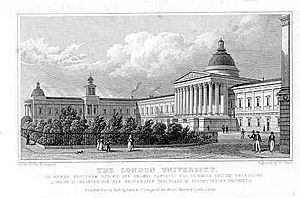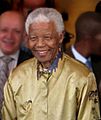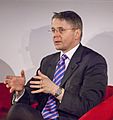University of London facts for kids
| Latin: Universitas Londiniensis | ||||||||||||
| Type | Public | |||||||||||
|---|---|---|---|---|---|---|---|---|---|---|---|---|
| Established | 1836 | |||||||||||
| Chancellor | HRH The Princess Royal | |||||||||||
| Vice-Chancellor | Professor Geoffrey Crossick | |||||||||||
| Visitor | The Rt Hon Nick Clegg As Lord President of the Council |
|||||||||||
| Students | 135,090 internal (2005-2006) 50,000 International Programmes |
|||||||||||
| Location | , | |||||||||||
| Colours |
|
|||||||||||
| Website | london.ac.uk | |||||||||||
The University of London is a very large group of universities and research centers in London, England. It's like a big family of 31 different schools and research places.
Its main office, called Senate House, is in a part of London called Bloomsbury. This area is close to other famous places like University College London and the British Museum.
The University of London is the biggest university in the UK when you count its full-time students. It has over 135,000 students studying on campus and more than 45,000 students learning through its International Programmes.
Each college within the University of London teaches its own students and does its own research. The main university body makes sure all the colleges meet high standards. It also handles degree exams and gives out the official certificates.
The university was first created in 1836 by a special document called a Royal Charter. This charter brought together two older colleges: London University (now University College London) and King's College (now King's College London).
If you graduate from the University of London, you can use special letters after your degree, like 'Lond.' or 'Londin.'. These come from the Latin name Londiniensis.
Some of the university's largest colleges include Birkbeck, Goldsmiths, King's College London, the London Business School, Queen Mary, Royal Holloway, SOAS, LSE and UCL.
A Look at the University's History

The University of London started in 1836 with just two colleges. One was University College London, founded in 1826. It welcomed all students, no matter their religion. The other was King's College, founded in 1829, which only accepted members of the Church of England.
Because of this, both University College and King's College were around before the University of London itself. At first, the University of London's main job was just to give exams for these colleges.
In 1858, the university grew its role. It started offering its degrees to students who weren't even attending its colleges. This was the first program of its kind in the UK. A new building was made to help with this new role.
A big step forward happened in 1878. The University of London became the first university in the UK to let women study and earn degrees just like men. In 1880, four women earned Bachelor of Arts degrees. The next year, two women earned Bachelor of Science degrees. These were also the first in the country.
Images for kids
-
Connaught Hall, a student residence located in Tavistock Square.
-
Somerset House in 1836. The university had its offices here from 1837 to 1870.
-
King William IV, who gave the University of London its first royal charter in 1836.
-
Mahatma Gandhi, a famous leader from India.
-
Nelson Mandela (LLB), a famous leader from South Africa.
-
John Snow (MB, MD), who helped found the study of how diseases spread.
-
John Hunter, known as a founder of modern surgery.
-
Florence Nightingale, who helped start modern nursing.
-
Achim Steiner (MA), who works for the UNDP.
-
Tedros Adhanom (MSc), the head of the World Health Organization.
-
Jeremy Heywood (Msc), a former top government official in the UK.
-
Margrethe II (Hon. LLD), the Queen of Denmark.
-
Aung San Suu Kyi (MPhil), a leader from Myanmar.
-
Elton John, a famous English singer and composer.
-
Mick Jagger, a famous English singer and composer.
See also
 In Spanish: Universidad de Londres para niños
In Spanish: Universidad de Londres para niños
























